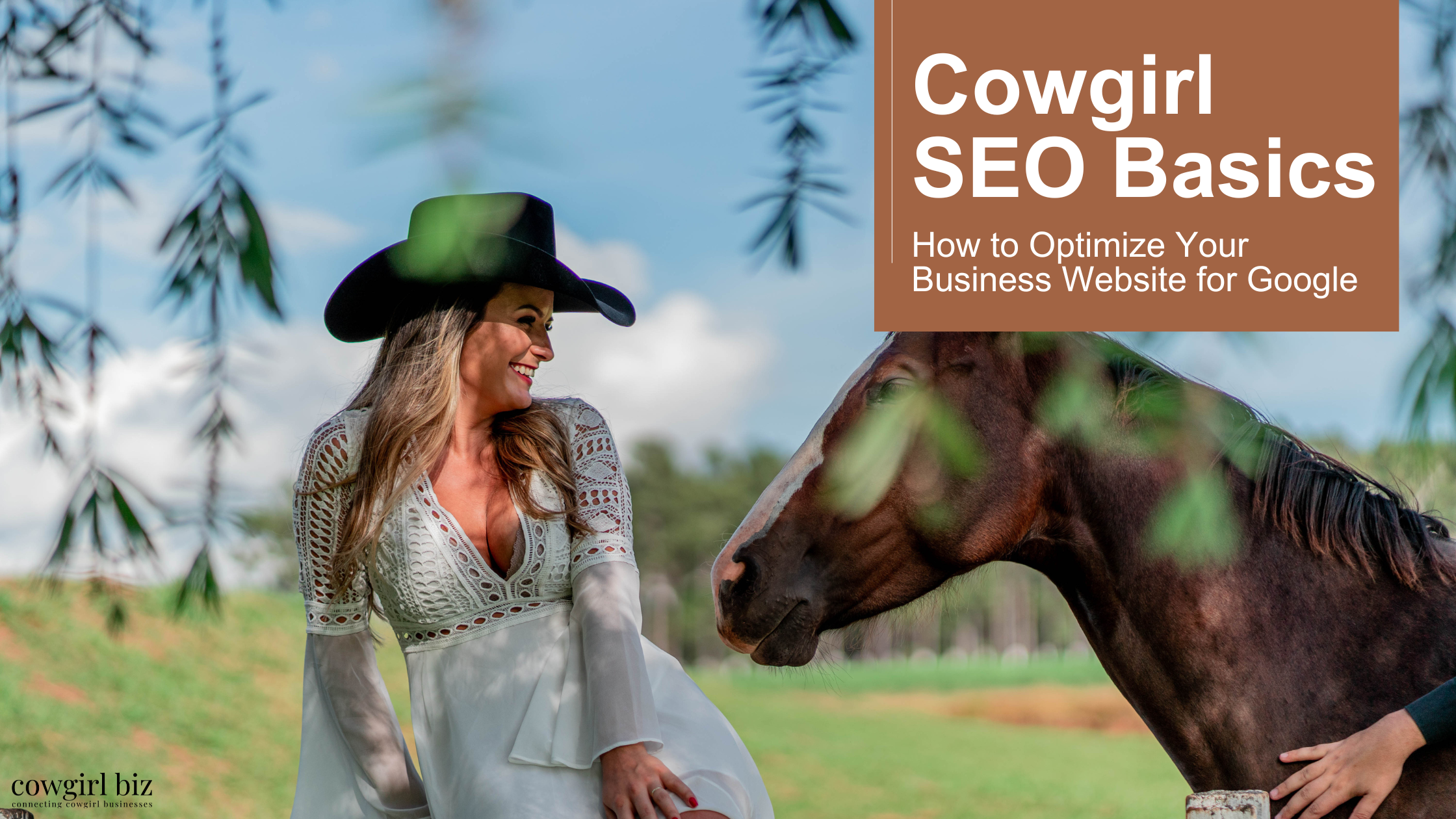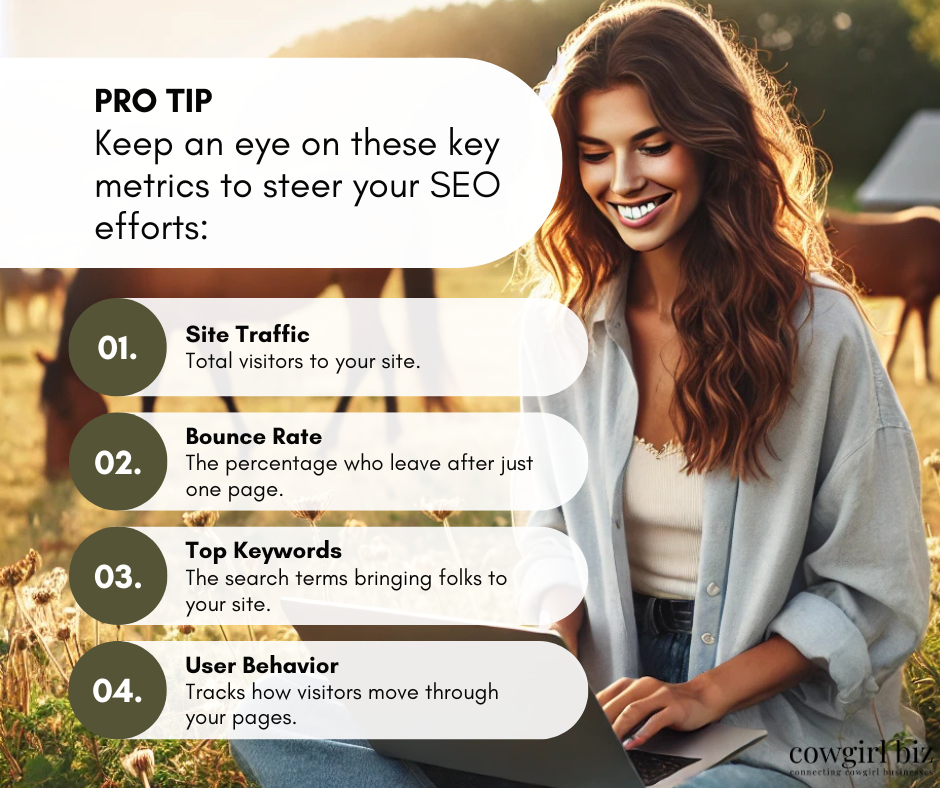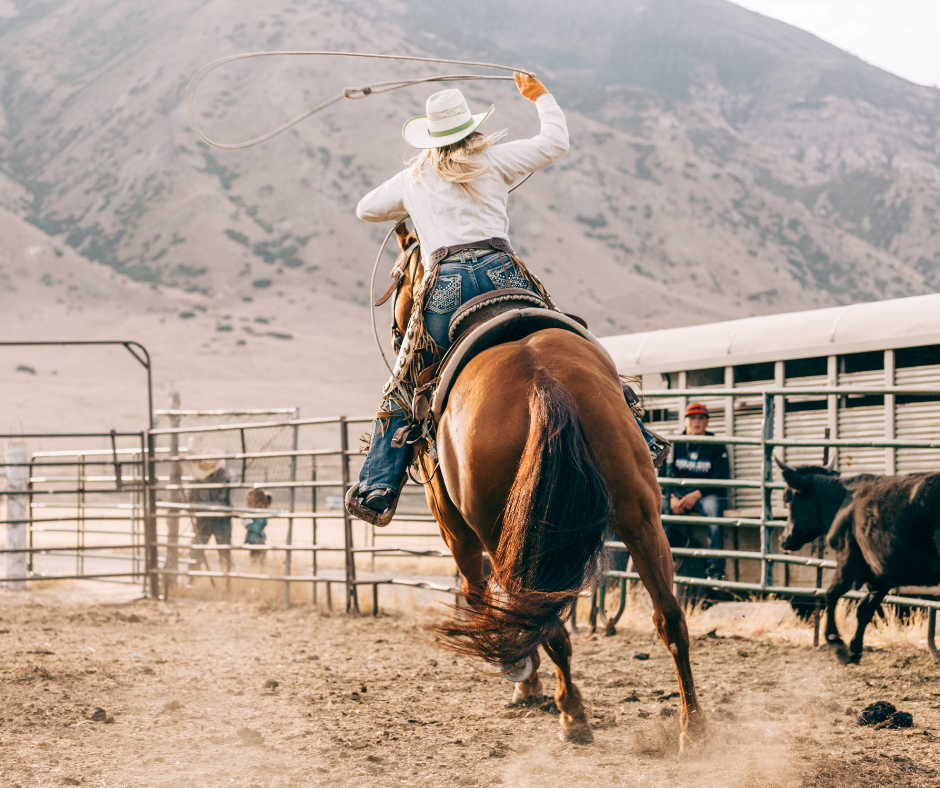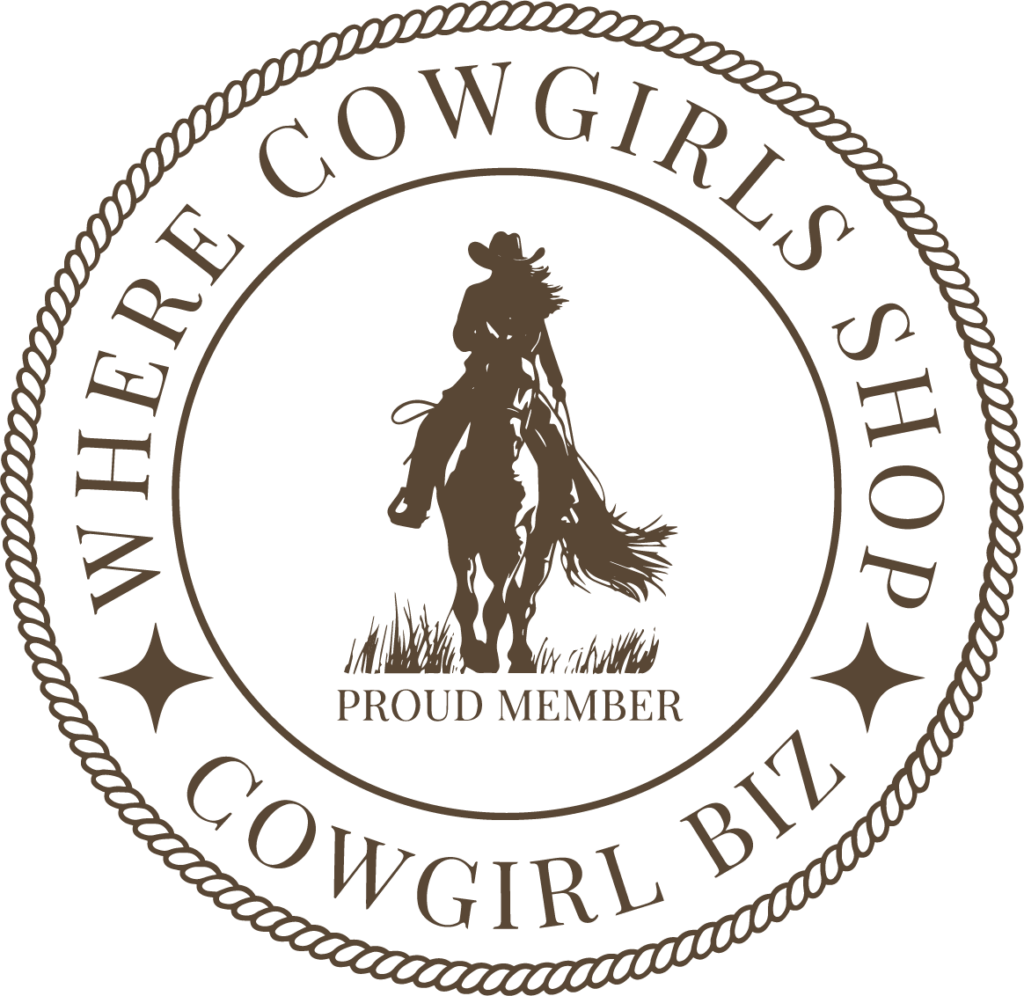
Want your cowgirl brand to stand out on Google? In today’s online world, it’s not enough to have a great product or service—visibility is everything. SEO helps your brand reach folks searching for exactly what you offer, building trust and drawing the right customers.
With these simple, beginner-friendly SEO steps tailored for cowgirl businesses, you’ll be ready to attract more of the right people without any tech know-how.
1. Set Up Your SEO Foundation
Setting up your SEO is like building a strong homestead—start with solid ground and the right tools. First, choose a fast and reliable hosting provider, like SiteGround, Bluehost, HostGator, or DreamHost, to keep your site running smoothly as a well-oiled saddle. A dependable host means quicker load times, which keeps visitors happy and helps your rankings.
Domain Name and SSL Certificate
- Pick a Memorable Domain: Choose a name that’s simple, brand-aligned, and easy to remember, like “WesternGoods.com.” A clear, keyword-friendly domain helps folks instantly know what you offer.
- Add an SSL Certificate: Just like locking up the barn at night, an SSL certificate keeps your site secure. It also earns Google’s trust, which boosts your rankings and shows visitors they’re safe on your site.
Get Google Analytics and Search Console Set Up
These tools are like your lookout tower, letting you see how folks find your site and what they do once they’re there.
- Google Analytics: Tracks visitors, their paths on your site, and how long they stay, helping you see what’s working.
- Google Search Console: Focuses on your site’s performance in Google searches, showing you what keywords are bringing folks in, plus any issues to fix.

Pro Tip: Keep an eye on these key metrics to steer your SEO efforts:
- Site Traffic: Total visitors to your site.
- Bounce Rate: The percentage who leave after just one page.
- Top Keywords: The search terms bringing folks to your site.
- User Behavior: Tracks how visitors move through your pages.
2. Keyword Research: Choosing the Right Words for Your Audience
Now that your site’s foundation is set, it’s time to find the words that will guide people straight to your door. Keywords are like trail markers—they connect your business to what folks are already searching for, helping Google know when to show your site.
Using the right keywords means you’re setting up pathways for your ideal audience to discover you.
Types of Keywords
Understanding the types of keywords can help you focus on terms that bring the right visitors to your site:
- Short-Tail Keywords: These are broad, general terms, like “Western boots” or “cowgirl accessories.” They have high search volumes but also stiff competition.
- Long-Tail Keywords: Longer phrases, like “handmade cowgirl leather boots,” “vintage cowgirl hats,” or “Western-style home decor,” are more specific and less competitive. They may bring in fewer people, but those visitors are often ready to buy.
How to Find Keywords
To discover the best keywords for your brand, start with these tools:
- Google Keyword Planner: Great for finding search volume and keyword ideas.
- Ubersuggest: Offers keyword suggestions and competition insights.
- Answer the Public: Shows common questions people are asking, helping you target terms that reflect real customer interests.
And see what’s working for others in your niche. Tools like Ahrefs and SEMrush (advanced but optional for beginners) let you peek into competitors’ keywords, helping you spot gaps or unique terms you can use to stand out.
3. On-Page SEO: Optimizing Each Page for Search Engines and Users
Once you’ve got your keywords, let’s put them to work on each page of your site. On-page SEO is all about fine-tuning elements that speak directly to search engines and make your site a pleasure for folks to explore.
Here’s how to make your pages shine:
Title Tags and Meta Descriptions
Think of your title tags and meta descriptions as the “signs” that guide visitors to your page. These little snippets are what people see first in search results, so they need to be catchy and clear.
- Why They Matter: A well-crafted title and description grab attention and encourage clicks, sending visitors your way.
- Best Practices:
- Keep titles under 60 characters and descriptions under 155 characters.
- Naturally, include your primary keywords, like “handcrafted cowgirl jewelry” or “vintage Western decor,” to let Google know what’s inside.
- Keep titles under 60 characters and descriptions under 155 characters.
Headers and Content Structure
Organizing content is like setting up a well-marked trail; headers (H1, H2, H3) guide visitors and make it easy for search engines to “read” your page.
- Why Use Headers: Headers break up the text, making it easy to skim, which is key since most visitors scan before they commit to reading.
- Best Practices:
- Use one H1 header for the main title on each page.
- Break content into sections with H2 and H3 headers to highlight key points, like “How to Style Cowgirl Boots.”
- Include keywords naturally within headers to help boost search visibility.
- Use one H1 header for the main title on each page.
Alt Text and Image Optimization
Images add charm to your site, but they need a little extra attention for SEO. Adding alt text—a description of what’s in the image—helps Google “see” your images and makes your site accessible for visually impaired visitors.
- Why It Matters: Alt text helps your images show up in Google’s image search, potentially bringing more traffic your way.
- Best Practices:
- Describe each image with specific keywords (e.g., “handcrafted leather cowgirl boots”).
- Compress images using tools like TinyPNG to keep them lightweight, which speeds up your site and improves user experience.
- Describe each image with specific keywords (e.g., “handcrafted leather cowgirl boots”).
Internal Linking
Think of internal links as paths that lead visitors deeper into your site. These links not only keep folks exploring but also help Google understand your site structure and which pages are most important.
- Why It’s Important: Internal links encourage visitors to stick around and engage with more of your content.
- Tips:
- Link naturally to related products or blog posts, like “How to Style Cowgirl Boots for Fall” or “Top Picks for Western Jewelry.”
- Use descriptive anchor text (the clickable text in a link) so visitors know what they’ll find.
- Link naturally to related products or blog posts, like “How to Style Cowgirl Boots for Fall” or “Top Picks for Western Jewelry.”
With these on-page SEO basics, your site will feel like a well-marked trail, guiding visitors straight to the Western-style products and cowgirl charm they’re looking for.


4. Local SEO Basics for Cowgirl Brands with Physical Stores or Local Services
To make sure your cowgirl business shines locally, start by claiming your Google Business Profile.
Think of it as putting up a big welcome sign—complete with your shop’s name, hours, address, and plenty of photos that show off your unique Western charm.
Adding accurate details builds trust with potential customers, and inviting happy customers to leave reviews adds to your credibility, helping you stand out in local searches.
Next, consider adding a local flavor to your website’s content. Posting articles like “Top Western Boutiques in [Your City]” or “Where to Find Cowgirl Accessories Near Me” can help draw in nearby folks who share your style.
And don’t forget to list your business on local directories like Yelp or, better yet, specialized spaces that love cowgirl culture as much as you do—like Cowgirl Biz. This helps boost your visibility and gives you valuable backlinks that make your site stronger in Google’s eyes.
Imagine joining Cowgirl Biz’s supportive marketplace, where your business is showcased alongside a community that shares your passion for the Western lifestyle.
Would you love to see your brand shining in a place where the cowgirl spirit thrives?
5. Content Creation: Write for Your Audience, Optimize for Google
Creating content is all about connecting with your audience, answering their questions, and showing them that your brand truly understands what they’re looking for.
Just like what you’re doing now—reading this blog because you’re interested in getting your cowgirl business noticed online—we actually did our homework to reach you.
We knew you’d be searching for “Cowgirl SEO basics,” “optimize website for Google,” “beginner SEO guide,” and “SEO for cowgirl brands,” so we made sure this content speaks right to your needs. That’s the magic of good research and targeted content!
Weave keywords naturally into blog posts, product descriptions, and headers so they flow effortlessly, guiding the right folks to your site.
And remember, it’s not just words—add images, videos, and infographics to boost engagement and keep people on your page.
6. Building Backlinks: Establish Your Website’s Authority
Backlinks are like trusted referrals in the digital world. They’re links from other sites pointing to yours, and Google values them because they signal authority and trustworthiness. The more quality backlinks you have, the more likely Google is to see your site as credible.
How to Build Strong Backlinks for Your Cowgirl Brand?
- Guest Blogging: Team up with Western or lifestyle blogs that attract your kind of audience. Sharing insights and stories about your brand here can lead to natural backlinks and new fans.
- Create Shareable Content: Craft content that’s valuable and fun to share, like “The Ultimate Guide to Western Outfits” or “Top Tips for Styling Cowgirl Boots.” When folks find it helpful, they’re more likely to link back to you.
Use tools to monitor where your backlinks are coming from and find new opportunities. Try Google Search Console for starters or Moz Link Explorer and Ubersuggest—they offer free options and are beginner-friendly. Tracking shows you who’s linking to you and gives insight into where to focus for future growth.
7. Track, Measure, and Adjust
Keeping an eye on your SEO metrics is like checking your trail map—it shows if you’re headed in the right direction. Key metrics to track include organic traffic, click-through rate (CTR), and keyword rankings.
SEO isn’t a set-it-and-forget-it strategy. Revisit and update your content every few months to align with new search trends and evolving audience interests.



